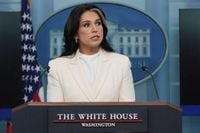The Office of the Director of National Intelligence (ODNI) is undergoing its most sweeping transformation since its founding in 2004, as Director Tulsi Gabbard announced a dramatic reduction in both workforce and budget, igniting fierce debate in Washington and beyond. The move, which will see the ODNI’s budget slashed by over $700 million annually and its workforce cut by more than 40%, is being implemented as part of the Trump administration’s broader campaign to slim down federal agencies and overhaul the intelligence community’s structure and mission.
Speaking to reporters at the White House on July 23, 2025, Gabbard described the changes as necessary to address what she called years of "bloat, inefficiency, and politicization" in the intelligence community. "Over the last 20 years, ODNI has become bloated and inefficient, and the intelligence community is rife with abuse of power, unauthorized leaks of classified intelligence, and politicized weaponization of intelligence," Gabbard said, according to the Associated Press. She emphasized that the reforms are designed to "end the weaponization of intelligence and hold bad actors accountable," aiming to restore the trust of the American people in their intelligence services.
The ODNI, established in the wake of the 9/11 attacks to coordinate the work of 18 separate intelligence agencies—including those focused on counterterrorism and counterintelligence—has long been viewed as a crucial hub for national security. But as Gabbard’s restructuring plan, dubbed "ODNI 2.0," takes effect, the agency is set to shed hundreds of jobs and consolidate key offices. According to Politico, the staff count, which stood at around 2,000 in February 2025 when Gabbard took the helm, has already dropped to about 1,500, and will fall further to roughly 1,300 after the cuts are complete. Staff affected by the layoffs will receive 60 days’ notice, as reported by Axios.
Among the most high-profile casualties of the overhaul is the Foreign Malign Influence Center (FMIC), a unit created in 2022 under the Biden administration to coordinate efforts against foreign disinformation campaigns and threats to U.S. elections. Gabbard has been sharply critical of the FMIC, accusing it of having a "hyper-focus" on elections and being used "to justify the suppression of free speech and to censor political opposition." She announced that the center’s core functions will be merged into other government operations and described the office as "redundant," echoing statements from senior officials who told NewsNation that its responsibilities overlap with those of the National Intelligence Council.
Yet some experts and former officials dispute the characterization of the FMIC as redundant. Emerson Brooking, a resident fellow at the Atlantic Council’s Digital Forensic Research Lab, argued to the AP that the center’s job was "supposed to solve for redundancy, not add to it." He emphasized the importance of having a dedicated office to parse intelligence assessments across agencies and alert decision-makers to foreign influence threats, particularly in the context of election security.
The FMIC is not the only office being eliminated or restructured. The Cyber Threat Intelligence Integration Center and the National Intelligence University will be either consolidated or closed, with some programs moving to the National Defense University. The National Counterproliferation and Biosecurity Center will see its core functions absorbed into the National Intelligence Council, with officials citing global health issues as "well outside of ODNI’s core mission." The External Research Council and the Strategic Futures Group—both accused by officials of injecting partisanship into the intelligence process—are also being eliminated. In addition, ODNI’s Reston campus will close, with operations consolidated at the main campus.
Gabbard’s announcement comes on the heels of other controversial moves by the Trump administration. In the week of August 20, 2025, the administration revoked the security clearances of 37 current and former intelligence officials, a decision that critics say risks violating the Privacy Act and undermines the integrity of the intelligence community. Gabbard accused those whose clearances were revoked of politicizing intelligence, leaking classified information, and manipulating assessments. The administration has also declassified documents aimed at questioning long-settled judgments about Russian interference in the 2016 presidential election, and has disbanded or downsized several offices focused on countering foreign influence and misinformation, including an FBI task force and the State Department’s Global Engagement Center.
The restructuring was developed after a months-long review by senior intelligence officials, who briefed President Trump two weeks before the public announcement. According to Axios, Trump had even considered shutting down the ODNI entirely, but Gabbard’s review concluded that it still serves an "important role" in coordinating intelligence activities across government. The changes are part of a broader cost-cutting mandate that has been a hallmark of the administration, with Elon Musk’s Department of Government Efficiency previously overseeing mass layoffs across the federal workforce. Gabbard’s plan ultimately aims to cut $1.3 billion across all 18 U.S. intelligence agencies in the coming years.
Reactions on Capitol Hill have been sharply divided along party lines. Republican Senator Tom Cotton, chairman of the Senate Intelligence Committee, praised the move as "an important step towards returning ODNI to that original size, scope, and mission. And it will help make it a stronger and more effective national security tool for President Trump." By contrast, Democratic Senator Mark Warner, vice chair of the Senate Select Committee on Intelligence, voiced deep concerns. "We will carefully review her proposals and conduct rigorous oversight to ensure any reforms strengthen, not weaken, our national security. But given Director Gabbard’s track record of politicizing intelligence—including her decision just yesterday to revoke security clearances from career national security officials—I have no confidence that she is the right person to carry out this weighty responsibility," Warner said, as reported by NewsNation. Representative Jim Himes called the cuts "a profound betrayal" of ODNI’s duty to protect Americans.
Gabbard, for her part, insists that the restructuring is about restoring the agency’s fundamental mission: "to provide objective, unbiased, timely intelligence" to the president and policymakers. She has pledged to support affected staff through the transition, offering resources and options for those being terminated or repositioned, including opportunities at agencies like the CIA.
As the dust settles on this historic overhaul, the future of the ODNI—and the broader U.S. intelligence community—remains uncertain. Supporters argue that the changes will reduce bureaucracy and refocus the agency on its core purpose, while critics warn of lasting damage to national security and the erosion of nonpartisan analysis. For now, one thing is clear: the intelligence landscape in Washington has shifted, and the consequences of these changes will be felt for years to come.


